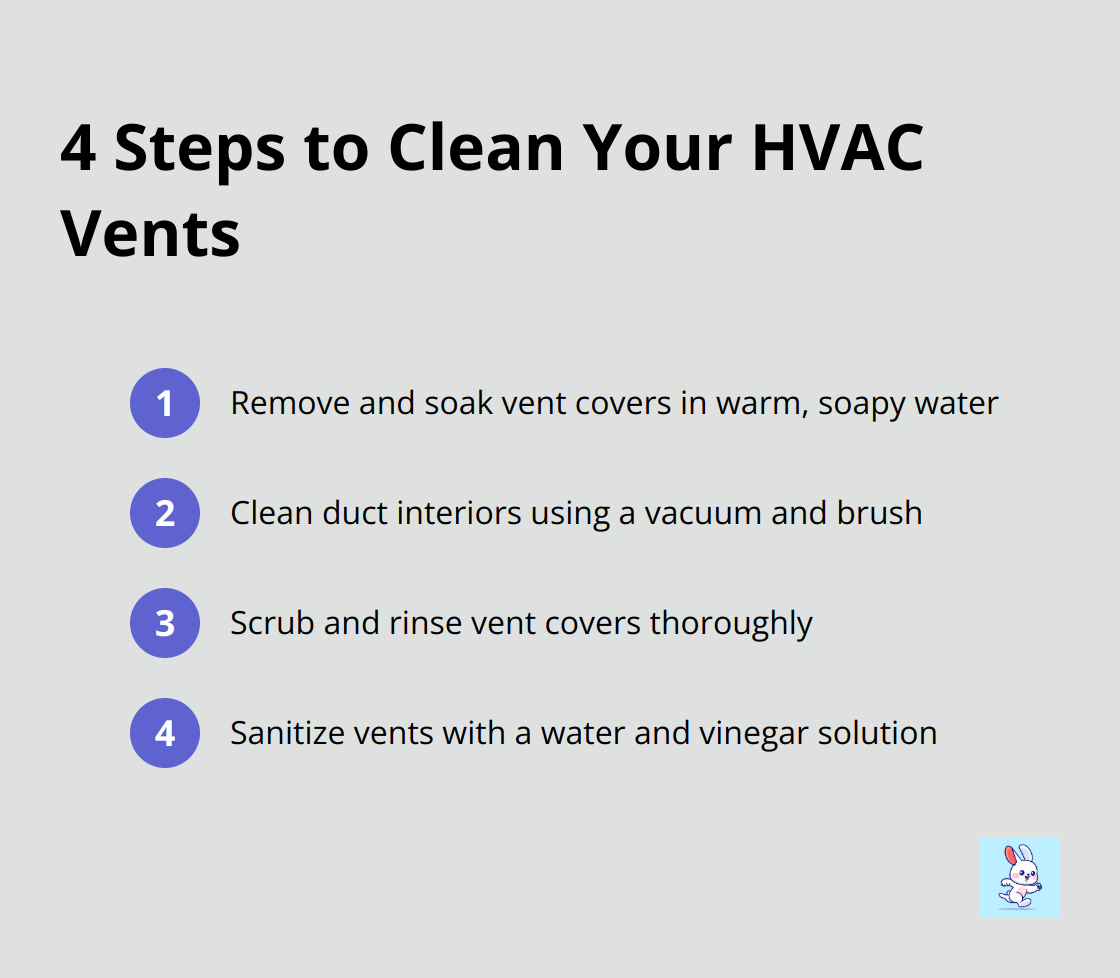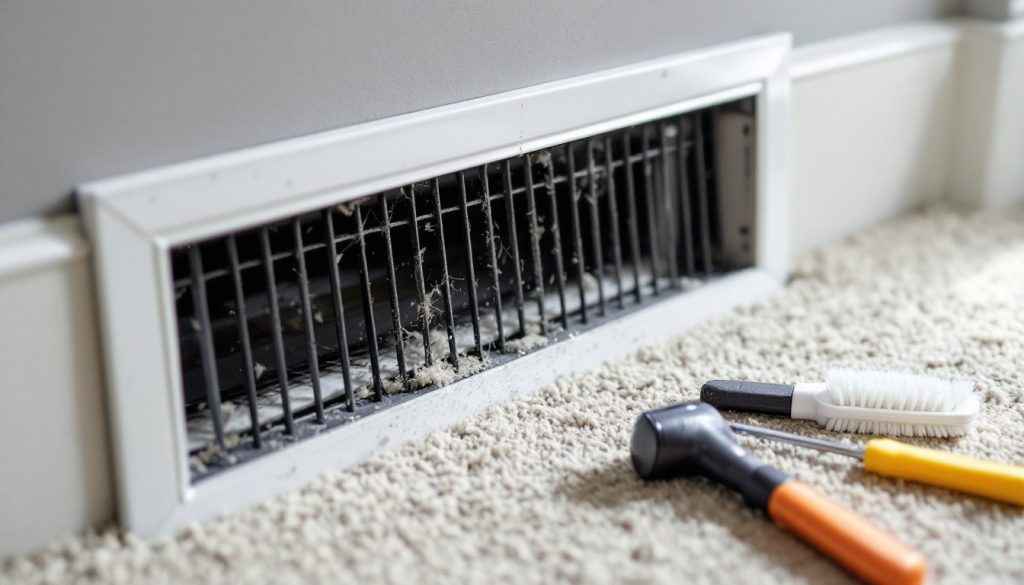At Cleaning Rabbit, we know that maintaining a clean HVAC system is crucial for indoor air quality and energy efficiency. While professional services like dryer air duct cleaning cost money, DIY vent cleaning can be a cost-effective way to keep your system in good shape between professional cleanings.
This guide will walk you through the process of cleaning your HVAC vents step by step, helping you improve your home’s air quality and potentially reduce energy bills.
How to Prepare for DIY HVAC Vent Cleaning
Assemble Your Cleaning Tools
To start your DIY HVAC vent cleaning project, you need the right tools. The AQ-R1500 Duct Cleaner makes duct cleaning a simple, one-person operation with its powerful 3,000-CFM Negative Air machine and 8″ x 8′ flex hose. Pair this with a stiff-bristled brush (such as a toilet brush or a large paintbrush) to remove stubborn dirt. Microfiber cloths will help you wipe down surfaces, and a bucket of warm, soapy water will clean vent covers effectively.
For those tricky areas, a flexible dryer vent brush can make a significant difference. These long, bendable brushes can navigate the twists and turns of your ductwork, reaching spots that standard cleaning tools can’t access.
Prioritize Safety Measures
HVAC systems often harbor various allergens and irritants. To protect your health, wear a dust mask or respirator to avoid inhaling particles. Safety goggles will shield your eyes from flying debris, and gloves will keep your hands clean and protected.
If you have asthma or severe allergies, ask a family member or friend to help with the cleaning process. The Asthma and Allergy Foundation of America (AAFA) joined with Allergy Standards Limited (ASL) to create the Asthma & Allergy Friendly® Certification Program, which can help you identify products that may be suitable for those with asthma and allergies.
Shut Down Your HVAC System
This step is essential for your safety and the effectiveness of your cleaning efforts. Find your thermostat and turn off both the heating and cooling functions. This prevents the system from activating while you work and blowing dust throughout your home.
For extra safety, shut off the power to your HVAC system at the circuit breaker. This eliminates any risk of electrical shock while you work near the unit.
Set Up Your Work Area
Before you begin cleaning, cover your furniture and floors with drop cloths or old sheets. This will catch any escaping dust during the cleaning process, making post-cleaning cleanup much easier.
Open windows to improve ventilation while you work. The Environmental Protection Agency (EPA) suggests increasing ventilation when performing activities that can generate indoor air pollutants.
These preparatory steps will set you up for a successful and safe DIY HVAC vent cleaning experience. However, if you encounter issues beyond your expertise, don’t hesitate to call in professionals. Companies with specialized equipment and years of experience in HVAC cleaning can provide expert assistance when needed.
The Asthma and Allergy Foundation of America recommends changing filters every 30-90 days to prevent the movement of allergens and irritants. This is a crucial part of maintaining your HVAC system:

Now that you’ve prepared your tools, safety gear, and work area, you’re ready to move on to the actual cleaning process. Let’s explore the step-by-step HVAC vent cleaning procedure in the next section.
How to Clean Your HVAC Vents

Remove and Soak Vent Covers
Start by removing all vent covers in your home. Most covers unscrew or unclip easily. Use a flathead screwdriver for stubborn covers. Label each cover with painter’s tape to remember its original location.
Soak the vent covers in warm water and mild dish soap. This mixture loosens built-up grime. While they soak, wipe down the visible parts of the ducts with a microfiber cloth to remove loose dust or debris.
Clean Duct Interiors
With covers removed, clean inside the ducts. Use your vacuum’s hose attachment to remove dust and debris. The Asthma and Allergy Foundation of America recommends changing filters every 30-90 days to prevent the movement of allergens and irritants.
After vacuuming, scrub the inside walls of the ducts with a brush attachment or long-handled brush. This action dislodges stubborn dirt and dust. Follow up with another round of vacuuming to remove the loosened debris.
Scrub and Rinse Vent Covers
Once the vent covers have soaked, scrub them thoroughly with a brush. Pay special attention to the slats where dust often accumulates. Rinse the covers thoroughly and dry them with a clean cloth.
Consider applying a thin layer of car wax to the covers before replacing them. This creates a protective barrier that makes future cleaning easier and helps repel dust.
Sanitize Vents
For extra freshness, sanitize your vents. Mix equal parts water and white vinegar in a spray bottle. Lightly mist the inside of the ducts and wipe with a microfiber cloth. This natural solution kills bacteria and neutralizes odors without harsh chemicals.
While DIY cleaning can significantly improve your vents’ condition, it’s not a substitute for professional cleaning. The National Air Duct Cleaners Association provides standards for assessing and evaluating the cleanliness of HVAC system components.
Now that you’ve cleaned your visible vents, you might wonder about the deeper sections of your air ducts. Let’s explore when and how to address these harder-to-reach areas in the next section.
How Deep Should You Clean Your Air Ducts?
Signs Your Air Ducts Need Professional Cleaning

Maintaining your HVAC system extends beyond cleaning visible vents. The hidden sections of your air ducts can accumulate dust, allergens, and mold, which may impact your indoor air quality. Several signs indicate a need for professional duct cleaning. A musty odor from your HVAC system, visible mold growth around vents, or unexplained allergy symptoms all suggest it’s time for a thorough duct cleaning. The Environmental Protection Agency (EPA) recommends duct cleaning when substantial visible mold growth appears inside hard surface ducts or on other heating and cooling system components.
DIY Methods for Light Duct Cleaning
You can perform light maintenance between professional cleanings to extend your DIY efforts beyond the vents. Use a long-handled brush or a vacuum with an extended hose to reach as far into the ducts as possible from the vent openings. Exercise caution to avoid damaging the ductwork or pushing debris further into the system.
Another DIY method involves using your HVAC system to your advantage. Install a new filter in your system and set your thermostat to “fan only” mode. This action will circulate air through the ducts, trapping loose debris in the new filter. Run this for several hours, then discard the filter and install another new one.
When to Call in the Professionals
DIY methods help maintain your ducts but don’t replace professional cleaning. NADCA recommends getting your air ducts inspected at least once a year, and cleaned as needed. However, homes with pets, smokers, or residents with allergies might benefit from more frequent cleanings.
Professional duct cleaning services use specialized equipment to reach deep into your duct system. They can access areas impossible to reach with DIY methods, ensuring a thorough cleaning of your entire HVAC system.
The CleaningRabbit Advantage
At CleaningRabbit, we use HEPA-filtered equipment to trap even the smallest particles, which prevents them from recirculating in your home. Our team (with over 20 years of experience in Las Vegas and Henderson) provides both residential and commercial duct cleaning services. We approach each job with the care and attention we’d give our own homes, ensuring you receive high-quality service.
The Importance of Regular Professional Cleaning
Regular professional cleaning can significantly improve your indoor air quality. This improvement potentially reduces allergy symptoms and increases your HVAC system’s efficiency. While DIY vent cleaning maintains your HVAC system between professional services, it doesn’t replace expert care.
Final Thoughts
Clean HVAC vents improve indoor air quality and reduce energy bills. DIY cleaning maintains your system between professional services, but doesn’t replace expert care. Professional duct cleaning reaches deep into your HVAC system, addressing areas inaccessible through DIY methods.
The dryer air duct cleaning cost is an investment in your home’s health and efficiency. CleaningRabbit uses advanced HEPA-filtered equipment to ensure comprehensive cleaning. Our team of experts (with over 20 years of experience in Las Vegas and Henderson) provides transparent pricing and personalized care.
Clean ducts mean cleaner air and a more efficient HVAC system. Regular maintenance creates a healthier home environment. When you need a deep, professional clean, CleaningRabbit will help you breathe easier and live healthier.

